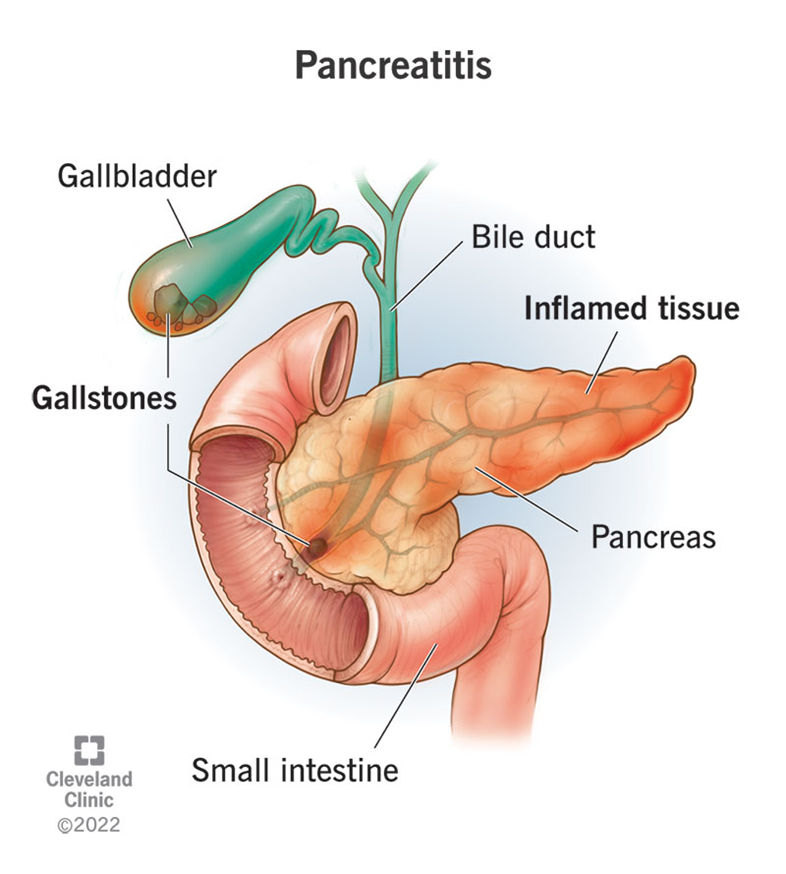A nurse admits a client to the emergency department who reports nausea and vomiting that worsens when he lies down. Antacids do not help. The provider suspects acute pancreatitis. Which of the following laboratory test results should the nurse expect to see?
Increased serum amylase
Increased serum calcium
Decreased WBC
Decreased serum lipase
The Correct Answer is A
Choice A Reason:
Increased serum amylase is a key indicator of acute pancreatitis. Amylase is an enzyme produced by the pancreas to help digest carbohydrates. In cases of acute pancreatitis, the pancreas becomes inflamed, leading to the release of amylase into the bloodstream. Elevated levels of serum amylase, typically more than three times the upper limit of normal, are a strong indication of acute pancreatitis. This enzyme level usually rises within a few hours of the onset of pancreatitis and can remain elevated for several days.

Choice B Reason:
Increased serum calcium is not typically associated with acute pancreatitis. In fact, acute pancreatitis can often lead to hypocalcemia (low calcium levels) due to fat saponification in the pancreas, where calcium binds with fatty acids. Therefore, an increase in serum calcium would not be expected in a patient with acute pancreatitis. Monitoring calcium levels is important, but an increase is not a diagnostic marker for this condition.
Choice C Reason:
Decreased WBC (white blood cell count) is not a characteristic finding in acute pancreatitis. On the contrary, acute pancreatitis often leads to an elevated WBC count due to the inflammatory response in the body. Leukocytosis (increased WBC) is a common finding in many inflammatory and infectious conditions, including acute pancreatitis. Therefore, a decreased WBC count would not be expected and does not support the diagnosis of acute pancreatitis.
Choice D Reason:
Decreased serum lipase is incorrect. Similar to amylase, lipase is another enzyme produced by the pancreas, which helps in the digestion of fats. In acute pancreatitis, serum lipase levels also increase significantly, often more than three times the upper limit of normal. Lipase levels tend to rise slightly later than amylase but remain elevated for a longer period, making it a useful marker for diagnosing acute pancreatitis. Therefore, decreased serum lipase would not be expected in this condition.
Nursing Test Bank
Naxlex Comprehensive Predictor Exams
Related Questions
Correct Answer is A
Explanation
Choice A Reason:
Hemoptysis, or coughing up blood, is a common feature of both mitral valve stenosis and mitral valve regurgitation. In mitral valve stenosis, the narrowing of the valve leads to increased pressure in the pulmonary veins, which can cause pulmonary congestion and hemoptysis. Similarly, in mitral valve regurgitation, the backflow of blood into the left atrium increases pulmonary pressure, potentially leading to pulmonary edema and hemoptysis. Therefore, hemoptysis is a shared symptom of both conditions.
Choice B Reason:
A high-pitched holosystolic murmur is more commonly associated with mitral valve regurgitation rather than mitral valve stenosis. In mitral valve regurgitation, the murmur is caused by the backflow of blood from the left ventricle into the left atrium during systole3. Mitral valve stenosis, on the other hand, typically presents with a diastolic murmur due to the turbulent flow of blood through the narrowed valve during diastole. Therefore, a high-pitched holosystolic murmur is not a common feature of both disorders.
Choice C Reason:
Hepatomegaly, or an enlarged liver, can occur in advanced cases of both mitral valve stenosis and mitral valve regurgitation due to right-sided heart failure. However, it is not a primary or common feature of these conditions. Hepatomegaly is more often associated with conditions that directly affect the right side of the heart or cause systemic congestion. Therefore, hepatomegaly is not a common feature of both mitral valve stenosis and mitral valve regurgitation.
Correct Answer is ["A","B","D","E"]
Explanation
Choice A Reason:
Aspirating the stomach contents is essential to ensure the nasogastric tube is correctly positioned in the stomach. This step helps verify that the tube has not migrated and is safe for medication administration. If the aspirate is not obtained, further steps should be taken to confirm the tube’s placement.
Choice B Reason:
Checking the residual volume is important to assess the stomach’s contents and ensure that the patient is tolerating the feedings or medications. High residual volumes may indicate delayed gastric emptying or other gastrointestinal issues. This information helps guide the timing and amount of medication administration.
Choice C Reason:
Removing the tube and placing it in the other nostril is not a standard practice before administering medication. This action is unnecessary and could cause discomfort or complications for the patient. The focus should be on verifying the tube’s placement and ensuring it is functioning correctly.
Choice D Reason:
Testing the stomach contents for a pH indicating acidity is a reliable method to confirm the nasogastric tube’s placement. Gastric contents typically have a pH of 1 to 5, indicating the tube is in the stomach. This step helps ensure the safe administration of medications.
Choice E Reason:
Turning off the suction to the nasogastric tube is necessary before administering medications. Suction can interfere with the absorption of the medication and may cause the medication to be removed from the stomach before it has a chance to take effect. Therefore, it is important to turn off the suction temporarily during medication administration.
Whether you are a student looking to ace your exams or a practicing nurse seeking to enhance your expertise , our nursing education contents will empower you with the confidence and competence to make a difference in the lives of patients and become a respected leader in the healthcare field.
Visit Naxlex, invest in your future and unlock endless possibilities with our unparalleled nursing education contents today
Report Wrong Answer on the Current Question
Do you disagree with the answer? If yes, what is your expected answer? Explain.
Kindly be descriptive with the issue you are facing.
